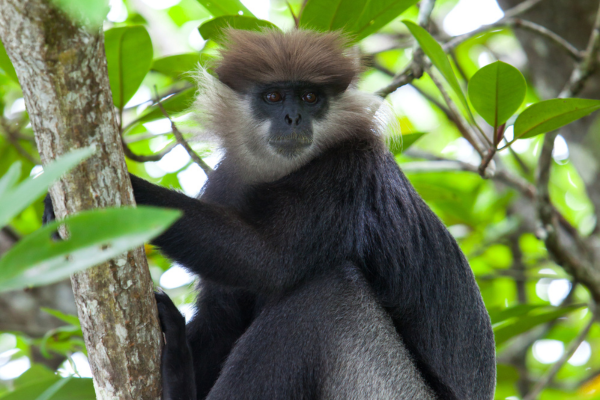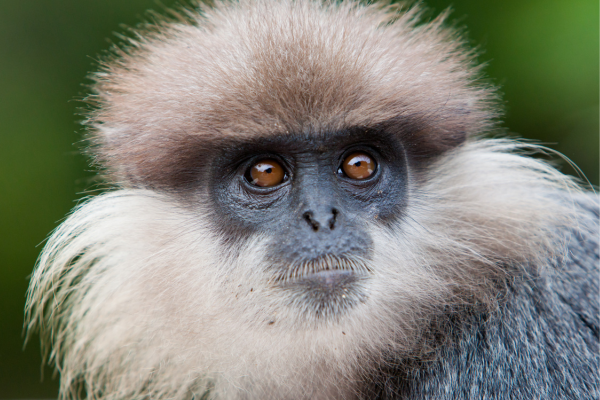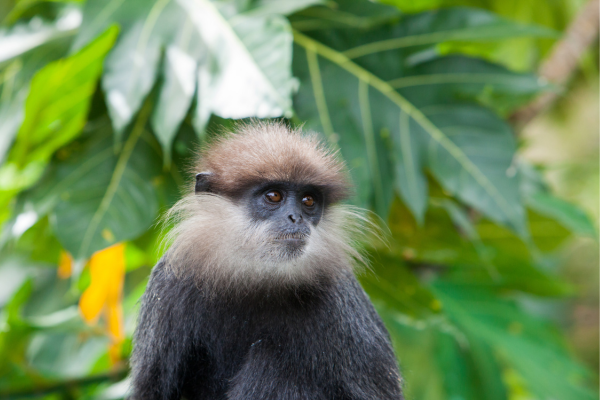Guardians of the Canopy: Exploring the Enigmatic World of the Sri Lankan Purple-faced Langur – By Nadeeka – eLanka
The lush landscapes of Sri Lanka conceal a world of astonishing biodiversity, with its forests harboring an array of unique and remarkable species. Among these, the Sri Lankan Purple-faced Langur (Trachypithecus vetulus) stands out as an iconic primate, both in its striking appearance and its vital role in maintaining the delicate balance of its ecosystem. This article delves into the captivating world of the Purple-faced Langur, exploring its biology, behavior, conservation status, and the importance of preserving its habitat.

Inhabitants of the Canopy
The Purple-faced Langur’s most distinguishing feature is its vibrant purple face, which contrasts vividly against its dark fur. Endemic to Sri Lanka, this langur species resides primarily in the island’s wet and evergreen forests. Its adaptation to an arboreal lifestyle is evident in its long tail, powerful limbs, and keen sense of balance, which enable it to gracefully navigate the complex network of branches and leaves that form its habitat.
Social Structures and Behavior
Purple-faced Langurs exhibit a complex social structure within their groups, known as troops. These troops are usually composed of multiple individuals, ranging from a few to over twenty members. Within these groups, there is a clear hierarchy, with dominant males often leading and protecting the troop. Females, on the other hand, play a crucial role in nurturing and raising the young.
One of the most fascinating aspects of their behavior is their diet. These langurs are primarily folivores, consuming a diet predominantly composed of leaves, supplemented by fruits and flowers. Their digestive system has evolved to cope with this challenging diet, utilizing a specialized stomach and fermentation processes to extract maximum nutrients from the fibrous vegetation.

Conservation Concerns
Despite their remarkable adaptations and critical ecological roles, Purple-faced Langurs face numerous threats that jeopardize their survival. Habitat loss due to deforestation, agriculture, and urban expansion has significantly reduced their natural range. Fragmentation of their habitat also isolates populations, making it harder for them to find mates and resources.
Additionally, langurs are sometimes hunted for their meat or captured for the illegal pet trade, further impacting their populations. The International Union for Conservation of Nature (IUCN) classifies the Purple-faced Langur as Endangered, highlighting the urgent need for conservation efforts to protect these unique primates.

Preserving a Fragile Legacy
Efforts to safeguard the Purple-faced Langur involve a multi-faceted approach. Establishing and managing protected areas, reforestation initiatives, and engaging local communities in conservation education are all crucial steps. Collaborative partnerships between government agencies, non-governmental organizations, and international stakeholders are essential to create effective conservation strategies.
Conclusion
The Sri Lankan Purple-faced Langur represents more than just a colorful primate species; it embodies the interconnectedness of life within its ecosystem. As stewards of our planet’s biodiversity, it is our responsibility to ensure the survival of species like the Purple-faced Langur. By understanding their unique biology, behavior, and the threats they face, we can work together to secure a brighter future for these enchanting creatures and the ecosystems they call home.







